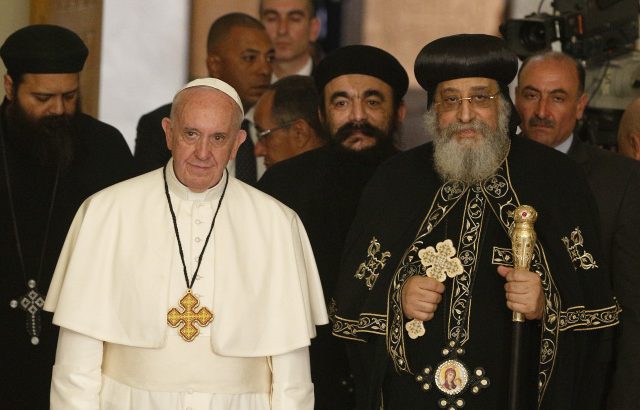The fastest growing religion in Ireland is poorly understood as our society’s growing secularism consumes public conscience.
It’s been well-documented that between the 2011 and 2016 census a large amount of people no longer identify as Catholic (although it is still overwhelmingly the largest religion at 78.3% of the population).
There is one Christian denomination that has grown by a huge 37.5% in just five years: Orthodox Christianity.
There are Eastern Orthodox Churches scattered across Dublin, but there are few outside the capital. Many worshippers rely on the Archbishop of Dublin, Dr Diarmuid Martin to allow them use of Catholic churches and spaces for worship.
Others, such as the Greek and the Russian Orthodox are well established, and now own their churches.
Growth
Prof. Tom Inglis, from the School of Sociology in UCD, says that overall the number of Orthodox Christians in Ireland has grown by almost 600% since the beginning of the century.
“While there has obviously been some conversion from other religions, I suspect that the majority is related to immigration,” Prof. Inglis told The Irish Catholic.
All the Eastern Orthodox Churches are in communion with one another, but there are distinctions, especially due to their unique cultures and language.
This means a worshipper from any Orthodox Church could visit another Orthodox church and know exactly what was happening, despite not knowing the language.
Prof. Inglis added that in Ireland there has been a diversification of the religious field in general, with “steady increases in non-Catholic denominations as well as large increases among those who say they have no religion”.
The Eastern Orthodox Church is the second largest Christian Church in the world after Catholicism, and differs from the papacy as it has no central governing structure.
Very Reverend Fr Geoffrey Ready is a programme co-director in the Orthodox School of Theology in Trinity College in Toronto, Canada, and was involved in setting up the first Orthodox church in Northern Ireland in 1999.
It was called the Holy Trinity in Belfast, it has since been closed down, but Fr Ready said it started a snowball effect which led to more churches being built.
He told the paper that as there wasn’t much immigration to the North of Ireland due to the Troubles, there was no demand for Orthodox churches.
“By the late noughties, immigration had started, so out of the original mission we worked on there are now basically four main churches in the Belfast area,” said Fr Ready.
He said he had a lovely opportunity at the time to speak to Catholics and Protestants for the Week of Prayer for Christian Unity to introduce Orthodoxy.
He said: “We had a few people who came from families where one was Catholic and one was Protestant, and they felt they were not welcome as a family in one particular Church. So they felt that coming to the Orthodox Church allowed them to worship together.”
The Canadian archpriest also said that Ireland has a very rich history relating to the saints, saying that Orthodox Christians would put a large emphasis on the veneration of saints, and they would regularly visit holy sites connected with them.
“Although it’s a kind of unknown quantity for a lot of people in the West, including Western Christians, really what Orthodox Christianity is all about is the original Apostolic Churches that come out of the Holy Land and the early Christian land surrounding that,” he said.
There was originally five main patriarchate in the early Church. Rome was in the West, and the four in the East were Jerusalem, Antioch, Constantinople and Alexandria.
The East-West schism occurred in the 11th Century, which saw the break in communion between the Catholic Church and the Eastern Orthodox Churches. Theological and ecclesiastical disputes such as the infallibility of the Pope and his universal jurisdiction, differences in Christology and the use of leavened (leaven is what’s placed in bread to make it rise) and unleavened bread caused the split.
Celibacy in the priesthood is also not mandatory in the Orthodox church. Men can be ordained if they are married, but they are not allowed to get married once they’ve been ordained. However, only celibate clergy are able to become bishops.
Language
Language also led to the two side’s differences, while Christians in the West spoke Latin, Greek became the most common language in the East.
Ireland always had a close relationship to the East compared to other Western countries such as Britain, France and Spain, according to the priest of the Russian Orthodox Church in Ireland, Fr Mikhail Nasonov.
“Historically the Irish Church was very close to the Eastern Church, it was a very unusual Church if you know Irish history,” he said.
“The Irish monks knew the Greek language very well. Greek was taught in the monasteries, the monks were very educated in Ireland, and they were able to read the Fathers in Latin and Greek as well. It was a great tradition of Christian teaching in Ireland.”
There are numerous autocephalous churches in Orthodoxy. This means each Church, such as the Russian, Georgian or Greek, have a Patriarch similar to the Pope, but he is seen as equal to the Patriarchs of the other Orthodox Churches.
Generally there can be no inter-communion between the two religions despite them being very closely linked – but in certain circumstances when permission is requested from the Pope, it is allowed.
Fr Ready said: “Through immigration people have moved into the West, that’s why you get Orthodox Churches arriving in places like the British Isles, Ireland, North America and other places.
“All of the communities that are in Ireland now, they will be identified with one or another of those ancient Churches, and usually that comes with an attachment to a particular language or culture – but they are all one faith.”
Blog
The first resident Orthodox priest in Ireland was Fr Nicholas Couriss who is believed to have fled Russia after the revolution in 1917 which saw the fall of the Tsar.
In a blog written by Irish priest and academic Fr Patrick Comerford he said Fr Couriss “was an officer in the Romanov Imperial Guard and during the Russian Revolution he joined the White Army”.
“He was reputed to have been involved in a plot to rescue the Russian Tsar and his family in Yekaterinburg in July 1918, but he always refused to speak of his role.”
After establishing a Russian language school in 1946 he became a priest in the first parish established in 1969 on Pembroke Lane in Dublin, but the parish closed when he died in 1977.
The Greek Orthodox are believed to have the longest established church in Ireland, and found permanent residence at Arbour Hill in Dublin which was consecrated in 1994.
With an influx of people from Eastern Europe in the 1990s the Russian Church began sharing the Greek Church’s premises in Arbour Hill, before finding a more permanent residence in the Holy Apostles Peter and Paul Church in 2002, in Harold’s Cross, Dublin.
The communities of Orthodox Christians existing in Ireland now include the Antiochian, Ethiopian, Georgian, Greek, Romanian, Russian and Coptic, and each have their own unique traditions under the same church. Many of Ireland’s new Orthodox may have fled from persecution, or had no hope or prospects in their country of origin. Oftentimes they are not only looking for their religion, but also the sense of community and comfort that they have lost.


 Chai Brady
Chai Brady Pope Francis is pictured with Coptic Orthodox Pope Tawadros II in Cairo April 28. The pope was making a two-day visit to Egypt. (CNS photo/Paul Haring) See POPE-EGYPT-ORTHODOX April 28, 2017.
Pope Francis is pictured with Coptic Orthodox Pope Tawadros II in Cairo April 28. The pope was making a two-day visit to Egypt. (CNS photo/Paul Haring) See POPE-EGYPT-ORTHODOX April 28, 2017. 